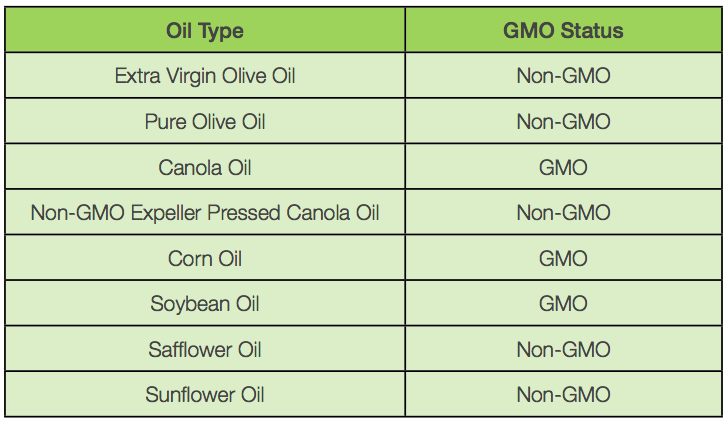If your manufacturing company is making the switch to non-GMO oil ingredients for your food products, you’re not alone.
Right now, food manufacturers across the US are busy swapping out the raw ingredients they’ve become familiar with for their non-GMO alternatives.
Others are in the midst of getting their products Non-GMO Project Verified™. To top it off, the majority of Whole Foods vendors are also making the switch to non-GMO ingredients, due to their 2018 cut off date for GMO labeling transparency.
We work with many Whole Foods vendors who manufacture their own natural or specialty food, so we’ve walked through this non-GMO transition process many times already with business just like yours. We also know it can be a bit of a complex change.
To make your new product development process a little bit easier, here’s a step-by-step guide for food manufacturers on how to swap your conventional ingredients out for their Non-GMO counterparts.
Step 1: Check your oil for GMOs
Determine which oil ingredient you’re using already, and make sure that it is in fact an oil that is grown using GMOs.
This first step is a double-check to confirm if you really need to make any changes.
If you’re using conventional soybean, canola or corn oil, chances are that you’re not using a non-GMO ingredient right now. These are 3 of the top 5 crops grown in the US and Canada that use GMOs in their production. They’re also some of the most common oil ingredients used in food manufacturing today.
Look at your oil spec sheet and label to get the real answer. Does your oil ingredient say Non-GMO on the label? Does it have a Non-GMO Project Verified™ seal (not necessarily required, but it’s an easy indicator)? These two signs are the easiest ways to figure out if your oil is a non-GMO alternative.
Another helpful hint? Know which oils are naturally non-GMO already. Olive, safflower, sunflower, and grapeseed oils are all typically non-GMO. This means that you don’t have to look for a “non-GMO” alternative, because what you’re buying already is.
This chart can be helpful to determine if the standard for the oil you use is GMO or non-GMO right now.

Step 2: Review your other options
Consider all of your alternative Non-GMO oil ingredient options.
If you are using a GMO oil like soybean, canola or corn right now, consider switching to a non-GMO oil. You’ll need to decide if you want to:
This decision may involve some market research to get feedback from your target market about what they’d prefer. It’s also helpful to understand the consumer “quality perception” of the different types of oils and how that will affect your products branding and sales.
Want to talk more about this? Set up a consult to discuss your options and the corresponding prices.
Step 3: Search for Non-GMO Oils
Do a search for an industrial manufacturing ingredient supplier who carries Non-GMO Canola Oil, or contact Centra Foods for a consult.
Chances are that if you’ve reached this website, you’ve probably already hit this step. Congrats, you already know that you want to look into switching to a non-GMO ingredient!
If you want to research your options or talk to someone who’s been through the process before, request a consult from one of our team members. You’ll talk about all of these steps, get pricing and advice for how to move forward from here.
The best part of this bulk oil consult, is that you’ll walk away with an idea of what’s going to work best in your product. Do you need a light flavor profile? Or maybe your target market demands an oil that has a really high perception of quality? How will your ingredients tie into the marketing that you do? All of this is important, and can be discussed with an expert at no obligation.
Step 4: R&D Test Runs
Decide on your best oil options, and do some test runs.
 Once you complete your consult, you’ll be able to walk away with a list of bulk oil ingredients that will work best for you. You may have pricing on hand already, but put it aside for now. It’s important to first find out what’s going to work in your product, and then get back to discussing the price ranges you think you need to be in.
Once you complete your consult, you’ll be able to walk away with a list of bulk oil ingredients that will work best for you. You may have pricing on hand already, but put it aside for now. It’s important to first find out what’s going to work in your product, and then get back to discussing the price ranges you think you need to be in.
Now that you know what non-GMO oils you’d like to try, start testing right away. If you need just a little bit of oil, your supplier may be able to offer you a sample for testing. If you need a drum for a larger test run, you can usually get around order minimums for short term testing needs.
If your supplier doesn’t provide samples, it may be cheaper to buy a few bottles from a local distributor or grocery store. Especially with items like canola oil and other mild oils, this is just fine to do-- it’s cheaper and will allow you to move into your R&D process right away.
Also, keep in mind as you’re doing your testing that the important thing to consider is how the raw ingredient affects your product’s final taste. Many oil flavors are cooked away or become minute when added as one of many ingredients. Even if an oil is a slightly different taste than you’re used to, don’t disregard it until you have a chance to try your final product with it.
Step 5: Share questions with supplier
If you run into any issues or questions during this testing process, use your supplier contacts as resources! They may have some good alternative ideas.
If you get into testing and struggle with the results you’re getting, come back to your supplier to discuss. As always, communication is key.
Tell them exactly what flavor/texture issues you’re coming up with. Or perhaps, marketing is struggling with their initial market feedback. Bring all of this information back to your supplier.
They live in the oil world day in and day out, and can usually offer some alternative options or insight that they’re seeing in the industry that could be helpful to you.
The goal is that by the end of this step, you’ve tested and re-tested and found a prioritized list of the non-GMO oils that may work for you, in the order of good, better, best.
Step 6: Do a price analysis
Request a price quote for the non-GMO oil, to be able to do an in-depth analysis of your options.
Request a price quote for the oils that R&D has determined could work well for you. This is the time where you can compare the pricing of a few different oils, and come up with the option that’s going to work the best for you in the long run.
When you’re looking at pricing, keep the following in mind:
- Look at industry average prices over the last 1-3 years. That way if prices change and go up or down (which they do, given that oils are commodity items) you can be prepared.
- Make sure to ask about any issues with availability that could affect you. For example, manufacturers using Organic Sunflower Oil and Organic Safflower Oil have struggled this past summer with increasing demand and limited availability. It’s better to know and be prepared than have issues later.
Step 7: Adjust product pricing if necessary
Determine if your product’s end pricing will have to change and if that is a worthwhile business decision.
 There’s a reason that I suggested getting pricing for these non-GMO oils after you do your initial testing.
There’s a reason that I suggested getting pricing for these non-GMO oils after you do your initial testing.
If you are in purchasing or the owner of your company, you always have the bottom line in mind. Well, by changing from a conventional oil that uses GMOs to a non-GMO oil, you’ll be actively choosing to buy an oil that is more expensive. Depending on the oils that work well in your products, it could be a big price jump or it could be a small one.
In situations like this where you are changing ingredients to a higher quality to delight your target market and potentially make more sales, it’s best to look at quality and results first and pricing second. That’s because, based on the results you get from the new ingredients and your market research, you may find that it’s worthwhile to increase your own products price to achieve the quality you’re looking for.
Let’s look at a story...
Dan owns a dressing company and has used conventional canola oil in the past. He could switch to Non-GMO Canola Oil and pay $0.20 - $0.40 /Lb more, OR he could switch to olive oil and pay a higher price. He spends a long time trying to decide what to do, and while he’s leaning towards non-GMO canola oil (because it’s cheaper), he’s still not sure which to pick.
Eventually, he begins asking his customers at his in-store demos at Whole Foods what they would prefer for him to switch to. Turns out, his customers keep answering that they would like to see olive oil. Why? It’s what they happen to use at home, and they think it’s a high quality. When he asks if they’d be willing to pay more for it, they say yes.
In the end, Dan chooses to switch to olive oil, because even though it’s more expensive, it’s the right business decision for his brand. He also ends up increasing his product’s price to help cover the cost.
Step 8: Come to a final decision
Discuss all these facets of the decision with your R&D department, marketing and your executive team to make a decision on your new non-GMO oil ingredient.
All these components will have to come together so that you can make a final decision on the right oil. Schedule a meeting with your executive team, purchasing, R&D (and potentially, even your oil supplier) to make a final decision on the best option.
Now you can begin purchasing your new non-GMO oil ingredient!
What else is a part of your non-GMO ingredient decision making process? Tell us in the comments below.
Topics: Non-GMO, Purchasing & Procurement












